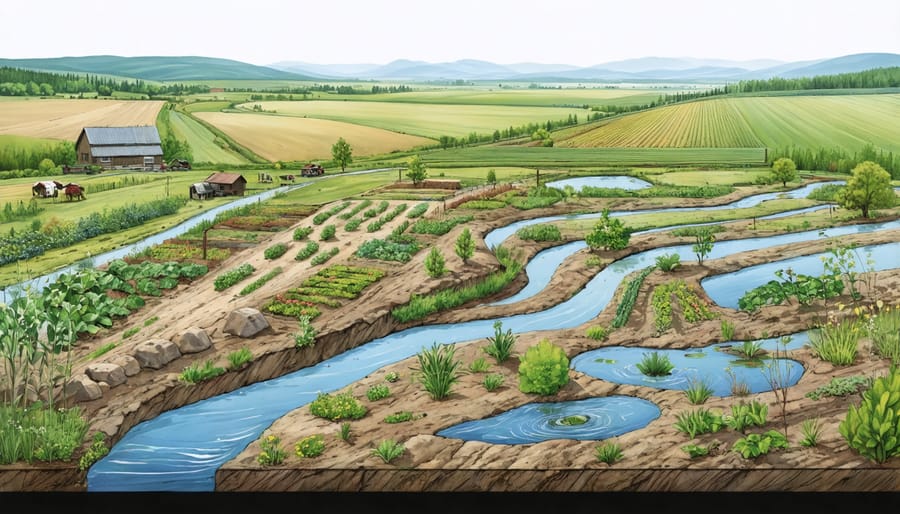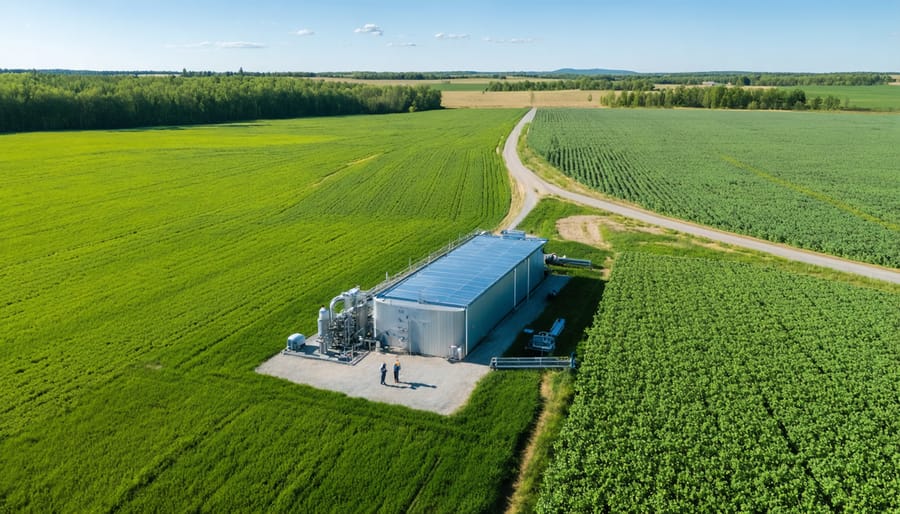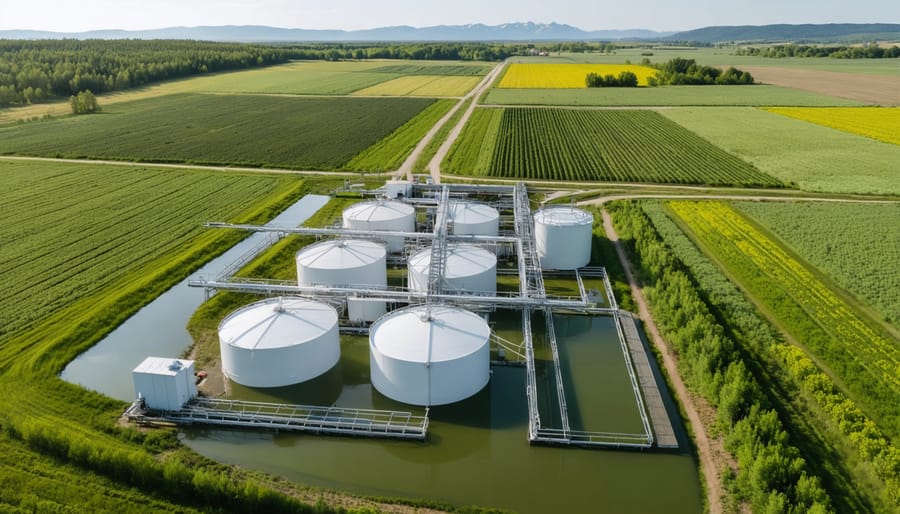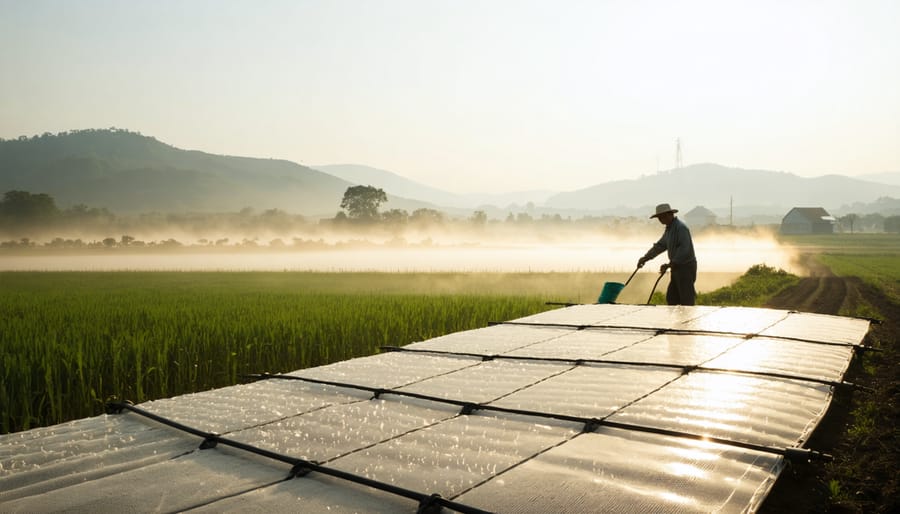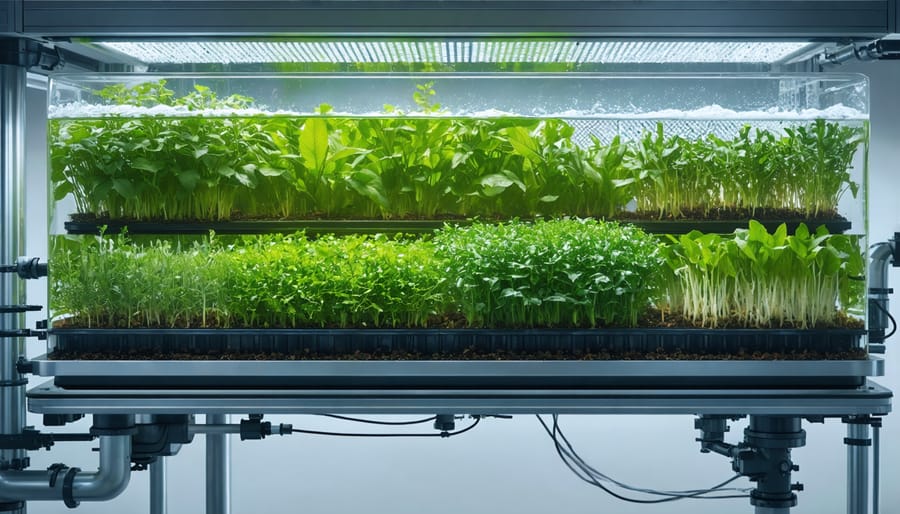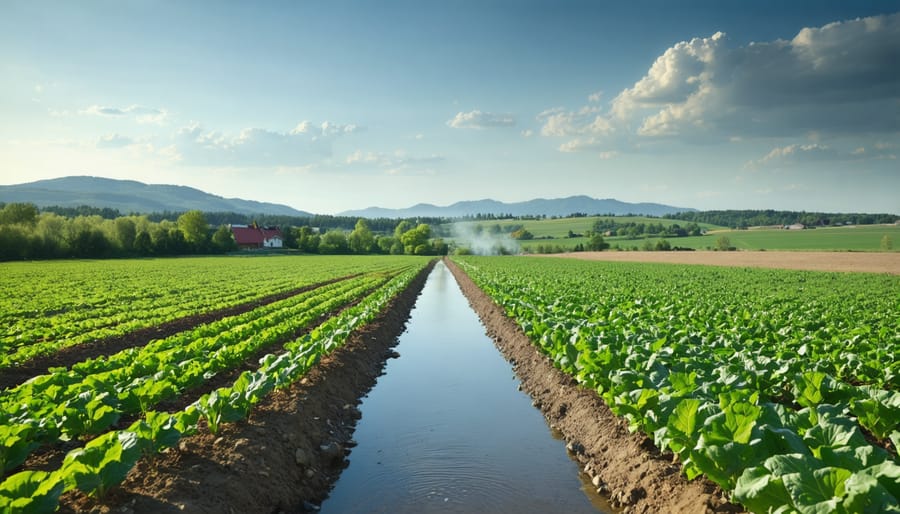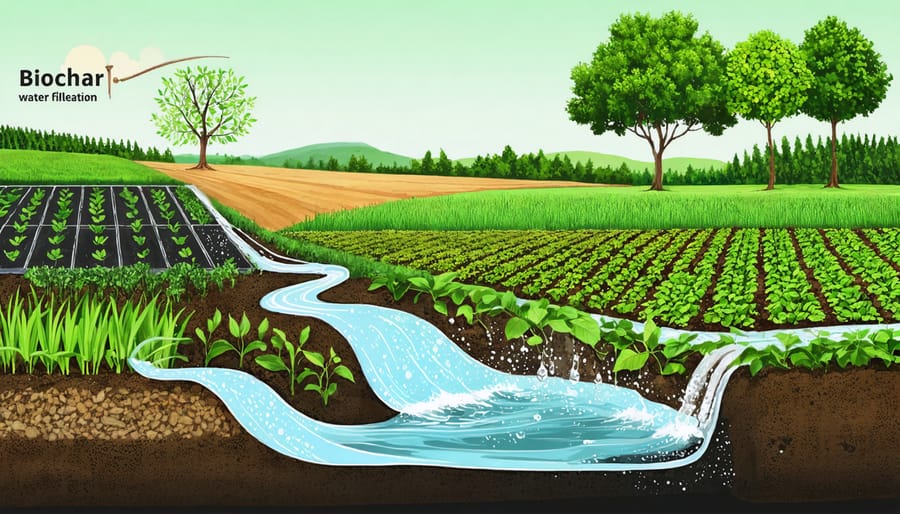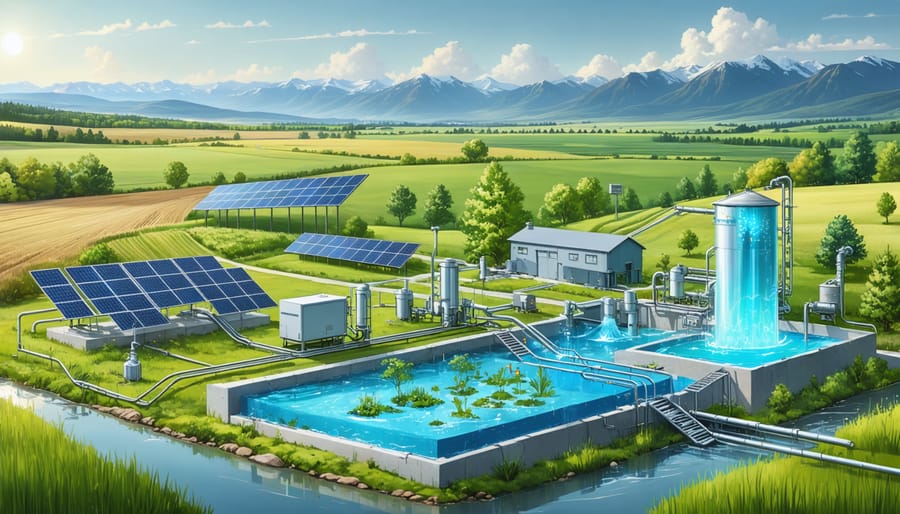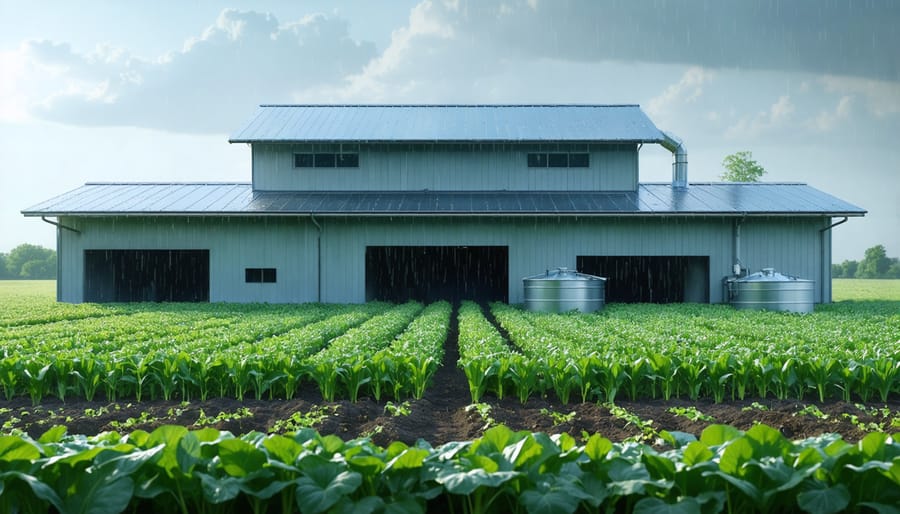Harness the natural flow of water across your land by designing strategic swales, berms, and catchment basins that mirror Alberta’s unique prairie watershed patterns. These time-tested permaculture systems reduce irrigation needs by up to 70% while building drought resilience into your farm’s DNA. From the sun-baked southern grasslands to the aspen parkland, Canadian farmers are revolutionizing water management through biomimicry and passive harvesting techniques that work with our challenging climate, not against it.
Water shapes the future of regenerative agriculture in Western Canada. As precipitation patterns shift and traditional farming methods strain our aquifers, permaculture water management offers proven solutions that enhance soil health, boost crop yields, and protect our precious water resources for future generations. By understanding how water naturally moves through the landscape, we can design systems that capture spring melt, maximize summer rainfall, and create moisture-rich microclimates that extend our growing season.
Through careful observation and strategic design, your farm can become a water-wise ecosystem that thrives in harmony with Alberta’s distinct environmental conditions. This comprehensive guide explores practical permaculture techniques specifically adapted for Canadian agriculture, backed by local case studies and decades of on-farm research.
Natural Water Flow Patterns in Alberta’s Landscape
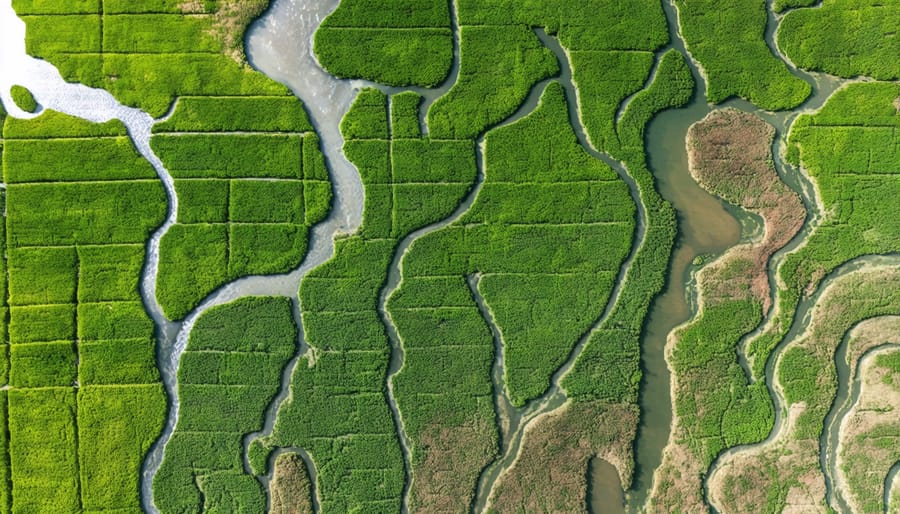
Understanding Your Farm’s Water Patterns
Before implementing any water management strategies, it’s crucial to understand how water naturally moves across your land. Start by observing and mapping your property during different weather conditions, particularly after rainfall. Pay attention to water infiltration patterns and identify where water naturally pools, flows, or runs off.
Create a basic contour map of your property, marking high points, depressions, and natural waterways. This doesn’t need to be complex – even a rough sketch can be valuable. Consider walking your land during a light rain to observe water movement firsthand. Look for signs of erosion, which often indicate areas where water flow needs to be managed.
Take note of existing features like buildings, roads, and tree lines that influence water movement. Many Alberta farmers find it helpful to document seasonal changes, as spring snowmelt and summer storms can create different patterns. Consider consulting local conservation authorities who can provide detailed soil maps and watershed information specific to your area.
Remember, understanding these patterns is your foundation for making informed decisions about water management strategies.
Common Water Challenges in Alberta
Alberta’s unique climate and geography present distinct water management challenges for farmers and gardeners. Our province experiences significant seasonal variations, with periods of drought followed by intense rainfall events. The semi-arid conditions in southern Alberta, combined with chinook winds, can lead to rapid soil moisture loss and increased evaporation rates.
Many Alberta farmers face issues with spring runoff management, particularly during sudden snowmelt periods. This often results in soil erosion and nutrient leaching. In central and northern regions, clay-heavy soils can create drainage problems, while sandy soils in other areas struggle with water retention.
Water rights and access present additional challenges, as Alberta’s water licensing system operates on a “first-in-time, first-in-right” basis. This can impact new farming operations and their ability to implement comprehensive water management systems.
Despite these challenges, Alberta’s agricultural community has shown remarkable resilience and innovation. Many farmers are successfully adapting by implementing water-conscious permaculture techniques, including keyline design, swales, and drought-resistant plant selection. These approaches help maximize the use of available precipitation while building long-term soil health and water retention capacity.
Practical Water Harvesting Techniques
Swales and Berms
Swales and berms form the backbone of effective rainwater harvesting systems in permaculture design. These earthworks consist of shallow trenches (swales) dug along land contours, paired with raised mounds (berms) created from the excavated soil. On Alberta’s rolling prairies, properly constructed swales can capture spring meltwater and summer rainfall, reducing erosion while replenishing groundwater.
To build effective swales, start by marking contour lines using a laser level or water level. Dig trenches approximately 1 metre wide and 30-50 centimetres deep, placing the soil downslope to form berms. Space multiple swales based on your land’s slope – typically 15-20 metres apart on gentle slopes, closer on steeper terrain.
Local farmer Dave Thompson from Red Deer County reports: “After installing swales three years ago, we’ve seen dramatic improvements in soil moisture retention. Areas that used to dry out by mid-July now stay productive through August.” Plant your berms with deep-rooted native species like prairie grasses to stabilize the soil and enhance water infiltration.
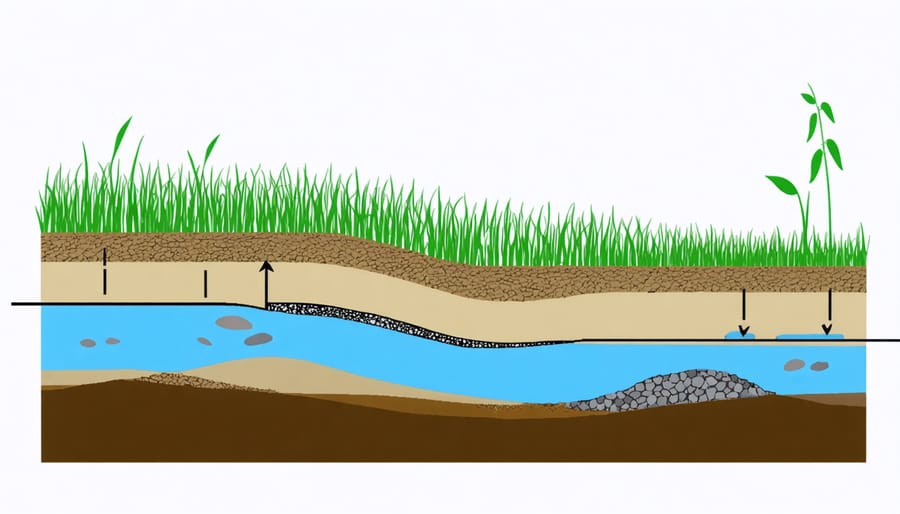
Rain Gardens and Bioswales
Rain gardens and bioswales are two powerful tools in the permaculture toolkit that help manage water flow while creating productive landscapes. Here in Alberta, where we often deal with both drought and intense rainfall events, these features can make a significant difference on your property.
Rain gardens are shallow depressions designed to capture and filter runoff from roofs, driveways, and other hard surfaces. By planting native species like Red-osier Dogwood and Blue Flag Iris, you create a beautiful space that also manages water effectively. These gardens typically process water within 24-48 hours, preventing mosquito breeding while recharging groundwater.
Bioswales take this concept further by creating longer channels that slow, filter, and direct water flow. On sloped properties, bioswales can reduce erosion while moving water to where it’s needed most. Many Alberta farmers have successfully incorporated bioswales along field edges, using them to grow moisture-loving crops like saskatoons and highbush cranberries.
To maximize effectiveness, design these features to handle your typical rainfall events plus 25% extra capacity. For most Alberta properties, a rain garden depth of 15-20 centimetres is ideal, while bioswales typically range from 30-45 centimetres deep.
Storage Solutions
In Alberta’s variable climate, having reliable water storage systems is crucial for permaculture success. Storage tanks come in various forms, with above-ground poly tanks being popular for their durability in our harsh winters. These tanks typically range from 1,000 to 10,000 litres and can be easily integrated into existing farm infrastructure.
Farm ponds serve as excellent natural storage solutions, particularly when strategically placed to catch spring runoff. Many Alberta farmers have found success with dugouts approximately 3-4 metres deep, which helps prevent excessive evaporation during summer months while providing enough depth to prevent freezing solid in winter.
Underground cisterns offer another practical option, especially for areas with limited surface space. These systems can store up to 20,000 litres and maintain stable water temperatures year-round. Local farmer Sarah Thompson from Red Deer shares, “Our underground cistern has been a game-changer for winter greenhouse operations.”
For smaller-scale operations, IBC totes (1,000-litre containers) provide flexible storage solutions that can be easily moved and connected in series. Consider incorporating swales and berms around storage systems to maximize water capture and prevent erosion during heavy rainfall events.
Efficient Irrigation Strategies

Drip Systems and Timing
Drip irrigation systems are game-changers for Alberta farmers looking to maximize water efficiency while maintaining optimal soil moisture. These systems deliver water directly to plant roots through a network of tubes and emitters, reducing water waste by up to 70% compared to traditional sprinkler systems.
For our climate, setting up drip lines 15-20 centimetres deep helps protect them from frost damage and reduces surface evaporation. Most local growers find success with pressure-compensating emitters, which ensure even water distribution across varying terrain – particularly important for our rolling prairie landscapes.
Timing is crucial for effective drip irrigation. Early morning watering (4-6 AM) typically yields the best results, allowing plants to absorb moisture before the day heats up. For most crops in our region, delivering 2-4 litres per square metre every 2-3 days works well during the growing season, though this should be adjusted based on rainfall and soil moisture monitoring.
Local farmer Sarah Thompson from Lacombe shares, “Since switching to drip irrigation, we’ve cut our water usage by half while improving our crop yields. The key is consistent monitoring and adjusting the schedule based on weather patterns.”
Consider using smart controllers that integrate with local weather data to automatically adjust watering schedules. These systems can pause irrigation before forecasted rain and adjust delivery based on temperature and humidity levels, making water management more precise and hands-free.
Mulching and Soil Management
In Alberta’s often challenging climate, proper mulching and soil management are crucial for water conservation in permaculture systems. By implementing effective mulching techniques, farmers can reduce water evaporation by up to 70% while improving soil health.
Local organic materials like straw, leaves, and wood chips create an insulating layer that maintains consistent soil moisture and temperature. For optimal results, apply mulch in layers 10-15 cm thick, ensuring the material doesn’t directly contact plant stems. This practice not only conserves water but also suppresses weed growth and adds organic matter to the soil as it breaks down.
Combining mulching with other soil management practices amplifies water retention benefits. Adding compost increases organic matter content, helping soil hold up to 20 times its weight in water. Deep-rooted cover crops like alfalfa and clover create natural water channels while improving soil structure.
Many Alberta farmers have found success using living mulches – low-growing plants that protect soil while fixing nitrogen. For example, the Henderson family farm in Red Deer reduced their irrigation needs by 40% after implementing a comprehensive mulching system with white clover as ground cover between their main crops.
Remember to adjust mulching strategies seasonally, using lighter materials in spring to allow soil warming and switching to heavier mulches during peak summer heat.
Real Results: Alberta Success Stories
Southern Alberta Drought-Resistant Farm
In the heart of Southern Alberta, fourth-generation farmer Sarah Thompson has transformed her 160-hectare property into a model of drought-resistant farming strategies through innovative permaculture techniques. Facing increasingly dry conditions and unpredictable rainfall patterns, Thompson implemented a comprehensive water management system that has increased her farm’s resilience while reducing water consumption by 40% over five years.
Key to Thompson’s success is her integrated approach to water conservation. The farm features a network of swales and berms that follow natural contour lines, effectively capturing and directing precious rainfall to where it’s needed most. These earthworks, spanning 2.5 kilometres across the property, slow water movement and allow for deep soil penetration.
Thompson complements these features with strategic keyline design, using gravity-fed irrigation channels that distribute water evenly across crop areas. The system includes three interconnected farm ponds that store spring runoff and act as wildlife habitats. Native drought-resistant plants line the swales, reducing erosion while providing beneficial insect habitat.
Perhaps most impressive is the farm’s soil management strategy. Through the application of organic matter and maintaining year-round soil coverage, Thompson has increased her soil’s water-holding capacity by 30%. This improvement allows crops to thrive with significantly less irrigation, even during prolonged dry spells.
The farm now serves as a learning centre for local agricultural students and farmers, demonstrating how traditional farming practices can be enhanced with permaculture principles to create resilient agricultural systems in challenging climates.
Central Alberta Market Garden
In 2019, Sarah and David Thompson transformed their 15-hectare property near Red Deer into a thriving example of integrated water management. Their market garden, which supplies produce to local farmers’ markets and restaurants, showcases how permaculture principles can work effectively in Central Alberta’s climate.
The Thompsons implemented a comprehensive water system that includes three interconnected ponds, swales on contour, and strategic keyline design. Their main pond, approximately 400 square metres, captures spring runoff and summer rainfall, while smaller ponds act as settling basins and wildlife habitats. The system has reduced their irrigation needs by 60% compared to conventional methods.
“We designed our water system to work with Alberta’s unique precipitation patterns,” explains Sarah. “The spring melt is crucial here, so we made sure to capture and store as much as possible for the drier summer months.”
Their success is particularly notable given the region’s challenges with sporadic rainfall and harsh winters. The system proved resilient during the 2021 drought, maintaining productivity while neighboring farms struggled. Key features include:
– Gravity-fed irrigation reducing pump costs
– Native plant buffers preventing erosion
– Winter-hardy water storage solutions
– Strategic placement of windbreaks protecting against evaporation
The Thompsons regularly host workshops for local farmers, sharing their experience and helping others implement similar systems. Their project demonstrates how traditional permaculture principles can be adapted for Alberta’s unique conditions, creating a more resilient and sustainable farming model.
As we’ve explored throughout this guide, permaculture water management offers practical, sustainable solutions for Alberta’s agricultural challenges. By implementing these strategies – from swales and rain gardens to efficient irrigation systems – farmers across our province are already seeing remarkable results in water conservation and soil health improvement.
Remember, successful water management isn’t about implementing every technique at once. Start small, perhaps with a simple rain catchment system or by redesigning your landscape to better direct water flow. Monitor your results, adapt your approach, and gradually expand your water management system as you gain confidence and experience.
The beauty of permaculture water management lies in its flexibility and scalability. Whether you’re working with a small market garden or managing hundreds of hectares, these principles can be adapted to suit your specific needs and conditions. The key is to work with your land’s natural patterns while considering our unique Alberta climate.
As our climate continues to change, implementing these water management strategies isn’t just about improving current yields – it’s about building resilience for the future. By sharing knowledge and experiences with fellow farmers, we strengthen our agricultural community and contribute to a more sustainable future for Canadian farming.
Take that first step today. Start observing your land’s water patterns and consider which techniques might work best for your situation. Remember, every positive change, no matter how small, contributes to the broader goal of sustainable agriculture in Alberta.

